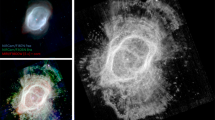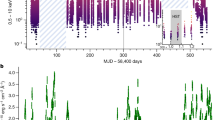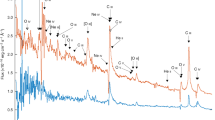Abstract
Low- and intermediate-mass stars lose significant fractions of their mass during the asymptotic-giant-branch evolution, creating massive circumstellar shells. The deeply enshrouded OH infrared stars are presumably at the end of asymptotic-giant-branch evolution. I report here the discovery of shocked bipolar bubbles expanding supersonically at right angles to a dense dust disk around the red-giant OH infrared star OH231.8+4.2. The relative radial velocity between the northern and southern bubble fronts is over 200 km s-1, and with a total physical extent of 0.42 pc and a known inclination, this gives a dynamical age of about 1,500 yr. Herbig–Haro objects are observed at the front of the bubbles, and are probably formed as instabilities in the bow shocks, where two collimated flows ram into the ambient medium. This new phenomenon represents a brief phase of late stellar evolution, immediately preceding the formation of a planetary nebula.
This is a preview of subscription content, access via your institution
Access options
Subscribe to this journal
Receive 51 print issues and online access
$199.00 per year
only $3.90 per issue
Buy this article
- Purchase on Springer Link
- Instant access to full article PDF
Prices may be subject to local taxes which are calculated during checkout
Similar content being viewed by others
References
Allen, D. A., Barton, J. R., Gillingham, P. R. & Phillips, B. A. Mon. Not. R. astr. Soc. 190, 531–536 (1980).
Cohen, J. G. & Frogel, J. A. Astrophys. J. 211, 178–180 (1977).
Cohen, M. Publs Astron. Soc. Pacific 93, 288–290 (1981).
Feast, M. W. et al. Mon. Not. R. astr. Soc. 203, 1207–1211 (1983).
Bowers, P. F. & Morris, M. Astrophys. J. 276, 646–652 (1984).
Morris, M., Bowers, P. F. & Turner, B. E. Astrophys. J. 259, 625–633 (1982).
Cohen, M., Dopita, M. A., Schwartz, R. D. & Tielens, A. G. G. M. Astrophys. J. 297, 702–709 (1985).
Sopka, R. et al. Astrophys. J. 294, 242–255 (1985).
Morris, M. Astrophys. J. 249, 572–585 (1981).
Zuckerman, B. & Aller, L. H. Astrophys. J. 301, 772–789 (1986).
Zuckerman, B. & Dyck, H. M. Astrophys. J. 304, 394–400 (1986).
Knapp, G. R. Astrophys. J. 311, 731–741 (1986).
Jura, M. & Morris, M. Astrophys. J. 292, 487–493 (1985).
Jura, M. Astrophys. J. 286, 630–632 (1984).
Spergel, D. N., Giuliani, J. L. & Knapp, G. R. Astrophys. J. 275, 330–341 (1983).
Author information
Authors and Affiliations
Rights and permissions
About this article
Cite this article
Reipurth, B. Shocked bipolar outflow from the evolved star OH231.8 + 4.2 . Nature 325, 787–790 (1987). https://doi.org/10.1038/325787a0
Received:
Accepted:
Issue Date:
DOI: https://doi.org/10.1038/325787a0
This article is cited by
-
OH–IR sources as precursors to protoplanetary nebulae
Nature (1990)
-
Stockert's chimney ? A galactic fountain
Astrophysics and Space Science (1987)
Comments
By submitting a comment you agree to abide by our Terms and Community Guidelines. If you find something abusive or that does not comply with our terms or guidelines please flag it as inappropriate.



